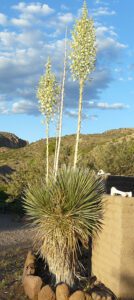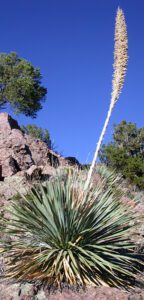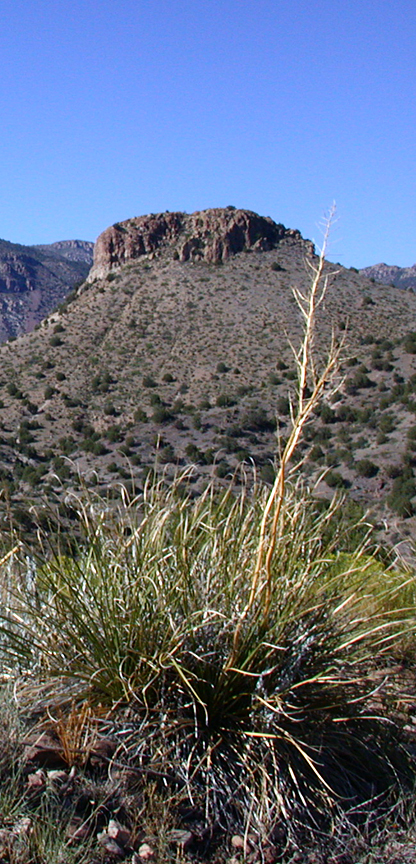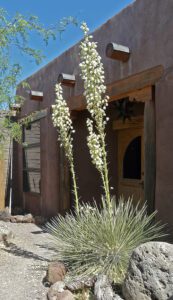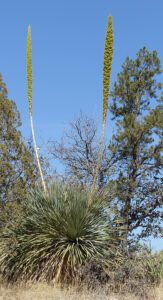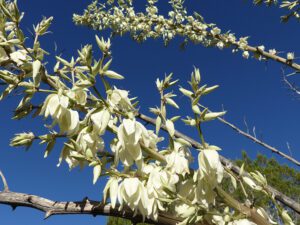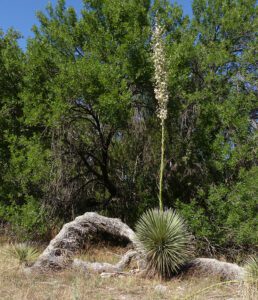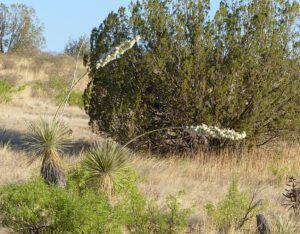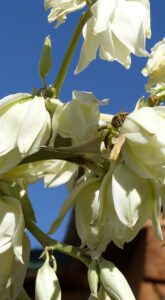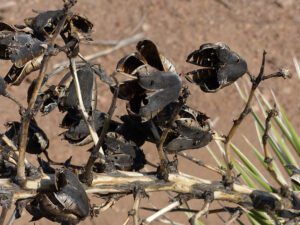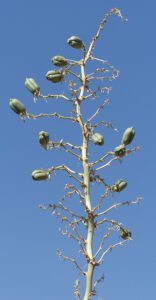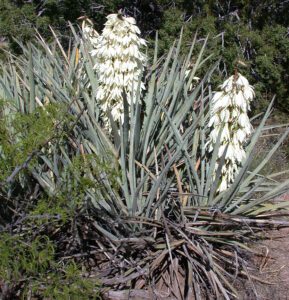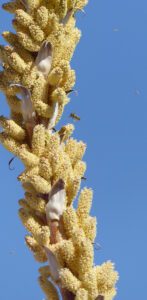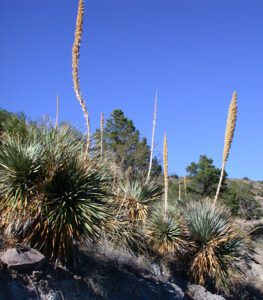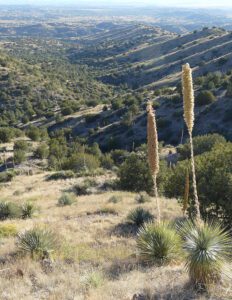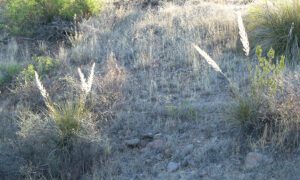These Iconic Plants of Southern New Mexico Were
Nature’s Grocery Store, Pharmacy, Fabric Shop, and Hardware Store
for the Native Americans of Southwest New Mexico
SHOWTIME IN THE HIGH CHIHUAHUAN DESERT
Beginning sometime in June, and generally peaking in early July, the Juniper and Piñon dominated High Chihuahuan Desert landscape surrounding Casitas de Gila Guesthouses often delights our guests with an extravagant Welcome-to-Summer white and golden flowering of the ubiquitous Yucca, Sotol, and Beargrass plants that thrive across this arid terrain. The magnitude of the flowering is a function of several factors, but primarily reflects the amount and timing of the previous Winter and Spring precipitation.
When all of the various factors are optimum over a Winter and Spring the display will be simply magnificent! No matter where one looks, the brilliant white flowering plumes of the Soaptree Yucca (Yucca elata) atop their 6-to-12 foot stalks, and the golden plumes crowning the soaring 10-to-16 foot stalks of the Sotol (Dasylirion wheeleri) can be seen in glorious contrast against the deep green of the Juniper trees or the cobalt blue of the New Mexican sky.
THE DESERT YUCCA
In 1927 the New Mexico Legislature established the blossom of the desert Yucca plant as the State flower. Only the Genus was specified, allowing the designation to apply to the several species of the plant growing within the State. Early settlers referred to these lovely flowers, which are found in all sectors of New Mexico, as “Our Lord’s candles” — “las lamparas de Dios” or the lamps of God. A magnificent flower at any time, for many it is when viewed on a full moon night, when the snow white plumes appear to float suspended in space high above the desert floor, that the ethereal beauty of the bloom is best appreciated.
There are some 40 to 50 species of Yuccas in the Americas and the Caribbean, all of which share the common characteristics of a basal, rosette, or circular arrangement of sword-shaped leaves and clusters of white or whitish flowers set at the top of a tall stem or stalk. Here at the Casitas there are two species of Yucca: the abundant Soaptree Yucca (Yucca elata) and the much less common Banana Yucca (Yucca baccata).
SOAPTREE YUCCA
The Soaptree Yucca (Yucca elata) has narrow, 0.25 inch, sword-shaped leaves 1 to 3 feet long, with needle-sharp tips, and grows to heights of 15 feet or more with a small diameter, occasionally branching, cylindrical trunk that is generally covered with a dense mat of dead leaves. Following the flowering phase, which consists of an inflorescence of large 1.25 to 2.25 inch bell-shaped flowers, the fruit appears in the form of numerous, large, three-chambered seed pods or capsules, two to three inches long and an inch in diameter. Each of these chambers contains two poker-chip-like stacks of flat black seeds. Eventually these pods dry and crack open, releasing the seeds to be spread by wind, surface water runoff, birds and animals. Various insects love the nectar of the Soaptree Yucca, but the flower is only pollinated by a species of the Yucca Moth.
BANANA YUCCA
The Banana Yucca (Yucca baccata) grows close to the ground, with only a short trunk, if present at all. The sword-shaped leaves are 1.25 to 1.5 inches wide, up to 3.5 feet long, with curled fibers along the margins, and needle-sharp tips. Height of the plant, including both the leaves and flower stalk rarely exceeds 4 or 5 feet high. While the flowers of the Soaptree Yucca and Banana Yucca are similar, their fruits are quite different. Unlike the more woody, tough, chambered seed pods or capsules of the Soaptree Yucca fruits, the Banana Yucca fruits are large, 3 to 6 inches long and 2.5 inches thick, fleshy, and soft and sweet when ripe. As a result they are much sought after as a food source by insects, birds, animals, and humans. Rarely do they reach ripening stage on the plant before being eaten. Like the Soaptree Yucca, the Banana Yucca is pollinated by a species of the Yucca Moth.
THE YUCCA AND THE YUCCA MOTH: A 30-50 MILLION-YEAR-OLD ROMANCE
Yuccas and Yucca Moths have been enjoying a romantic relationship for some 30 to 50 million years now. What has kept them together all those years makes for an interesting love story in intra-specifc relationships . . .
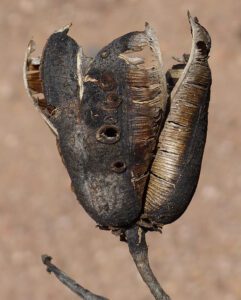
Yuccas reproduce by seeds produced from the pollination of the flowers. The flowers of Yucca plants are pollinated by three genera of the family of moths known as Prodoxidae. Certain species of two of these moth genera, the Tegeticula and the Parategeticula, have what is called an obligate pollination mutualism arrangement with particular species of Yucca. What this means is that certain species of Yucca are only pollinated by a particular species of Yucca Moth, an evolutionary development in which both species are mutually benefited, which, in this case, is by successful reproduction.
For the Soaptree Yucca the mutualistic Yucca Moth is Tegeticula yuccasella1. In this torrid relationship, the female moth first deposits an egg in the flower’s ovary, after which, in a display of impassioned gratitude, she collects a large ball of pollen from the flower, two or three times the size of her head, and then inserts it into the stigma of the flower! After a week or so the egg hatches there and the baby moth larvae will munch on some of the seeds developing from the ovules. After a few weeks, the seed capsules begin to open, at which time the mature larvae now bores its way out of the capsule and tumbles to the ground where it bores down into the ground, forms a silken cocoon, and begins a long winter’s nap while waiting for next season’s Yucca flowers, at which time it will complete the cycle and emerge from the ground as a new Yucca Moth!
The Banana Yucca and the Yucca Moth also have a obligate pollination mutualism relationship in which the romantic modus operandi of the moth, Tegeticula baccatella, is essentially the same as that of Tegeticula yuccasella.
MODERN USE OF YUCCA
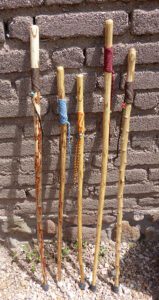
Today, all species of New Mexican Yucca are extensively used in xeriscaping because of their extremely low water requirements and their iconic Southwestern beauty. They are easy to grow and once established require virtually no maintenance.
The flower stalks of the Yucca are extremely strong and light, therefore they make excellent walking or hiking sticks. Here at the Casitas we provide them as walking sticks, and also use and decorate them as a Christmas tree in each Casita. Compared with other natural woods, Yucca as well as Sotol stalks have an exceptionally low ignition temperature. Consequently, they are excellent as drill and hearth or fireboard material for outdoor primitive friction fire starting using the plough, handrill or bow techniques as used by hunters, campers and practitioners of wilderness survival skills.
The use of Yucca as well as Sotol stalks in various types of building construction was widely practiced by both Anglo and Hispanic settlers in the traditional architecture of the Southwest, from crude enclosures of various kinds to the unique latillas over vigas in room ceiling construction. Modern construction of traditional architecture continues such use.
SOTOL
Sotol (Dasylirion wheeleri) is a common flowering plant of the arid Southwest found in both the Sonoran and Chihuahuan Deserts. At first glance the plant can be mistaken for a Soaptree Yucca with its rosette or globe-shaped mass of 0.50 to 1 inch wide and 1 to 3 foot long sword shaped leaves radiating in all directions at the top of a short, 5 foot or less, brown unbranched trunk cloaked in dead leaves. Looking closer, however, one quickly sees or perhaps is unfortunate enough to feel that the leaves have dangerously sharp barbs or saw-tooth spines lining the leaf margins.
MODERN USE OF SOTOL
In the U.S. the Sotol plant is often used for xeriscaping like the Yucca, although its flower is less showy and and saw-tooth barbs on the leaves render it less friendly or desirable in gardens. The woody flower stalks are strong and light like the Yucca and are frequently handcrafted into walking and hiking sticks, and some practitioners of friction fire starting prefer Sotol over Yucca as a hearth or drill material.
In Northern Mexico, mostly in the region of Chihuahua, however, Sotol is wild-harvested on a commercial scale where the hearts of the crown are baked, femented, and double-distilled to make a spirit liquor that is somewhat similar to tequila and mezcal.
BEARGRASS
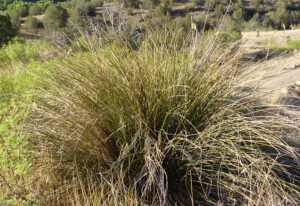
Beargrass (Nolina microcarpa) can be considered a distant relative of both Yucca and Sotol in that all three belong to the family of flowering plants known as the Asparagaceae, of which the namesake Genus Asparagus belongs, as well as our favorite Spring vegetable species, Asparagus officinalis.
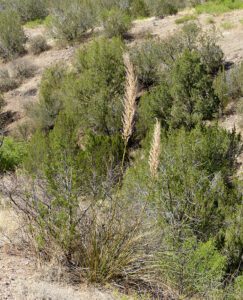
Beargrass is widely spread over the American Southwest and Northern Mexico. Its growth form is that of a globular clump of narrow, 0.50 inch, coarse, thick, wiry, and serrated grass-like leaves up to 4 feet long with dry, curled and string-like tips. It grows in a variety of habitats from desert grasslands to juniper and piñon woodlands, and especially in overgrazed ranch land where the plant can attain dense concentrations with individual plant diameters of 6 feet and a height of 4 to 5 feet.
Beargrass has no above ground stem or stalk, but rather an underground woody caudex from which the leaves and flower stalks grow. Like the Yucca and the Sotol at the time of flowering it puts up a stem or stalk 4 to 6 feet tall, at the top of which is found a much-branched inflorescence of tiny white flowers, 0.10 inch, which produce small green fruits and eventually encapsulated seeds.
MODERN USE OF BEARGRASS
Beargrass is another southwestern plant mostly used in xeriscaping, particularly as an accent, in borders, and in stabilizing hillsides.

NATIVE AMERICAN USE OF YUCCA, SOTOL AND BEARGRASS
Various species of Yucca, Sotol and Beargrass were widely used by all cultures of Southwestern Native American Cultures from pre-historic to historic times. These three plants were extremely important to these cultures, serving as Nature’s grocery store, pharmacy, fabric shop, and hardware store in those times. Many of these uses and customs are still practiced today.
The following categories, uses and practicing cultures are documented in the University of Michigan at Dearborn Ethnobotany Database.2
Soaptree Yucca (Yucca elata)
Medicinal Use
Peeled stalk shaped like a short snake eaten by a practitioner and spit at the sick (Apache)Food Use
Flowers boiled and eaten as vegetable, added to soups, or dried for later use. (Apache)
Trunks baked overnight in rock-lined pits and dried in pieces for later consumption after softening in water (Apache)
Trunks pit cooked, dried, and pounded into flour (Apache)
Young flower stalks cooked, peeled, and eaten hot (Apache)
Flower stalk charred and eaten like sugar cane (Apache)Fiber Basketry
Leaves woven into shallow baskets or trays for carrying things (Apache)
Leaves used as the binding element in coarse coiled ware (Papago)
Red roots used as basket decorations (Apache)Fiber Cordage (ropes, string, binding material)
Leaves used to make cordage (Apache)
Leaves tied to make a fastening loop for sandals (Southwest Native Americans)Fiber Furniture
Leaves used for the headshade of cradleboards (Apache)Fiber Building Material
Used for weft (horizontal lashing) in house frames (Papago)Fiber Sewing Material
Thread-like fibers from pounded leaves used to sew fiber coils into tight baskets (Papago)
Thread-like fibers woven into nets for carrying things (Pima)Fiber Mats, Rugs and Bedding
Leaves woven into mats (Pima)Soap
Roots used for making soap (Apache, Pima, Navajo)
Banana Yucca (Yucca baccata)
Medicinal Use
Dermatological aid for washing hair (Keresan Pueblo, Apache)
Infusion of pulverized leaves remedy for vomiting, heartburn (Navajo)
Fruits eaten raw as as a purgative or laxative (Pima)
Unspecified parts chewed as emetic to induce vomiting (Tewa)
Fruit eaten to promote easy childbirth (Tewa)Food Use
Dried fruits dissolved in water for beverage (Acoma Pueblo, Papago)
Fruit used to make a fermented beverage (Hualapai)
Fruits eaten raw, baked or boiled, or dried, made into cakes or rolls, and stored for future or winter use (Acoma Pueblo, Keresan Pueblo, Apache, Havasupai, Hopi, Hualapai, Navajo, Papago, Pima, Zuni)
Ripe fruits dried, ground, made into cakes and roasted (Navajo)
Ground dried fruit cooked with cornmeal to make gruel (Navajo)
Dried fruits eaten as a preserve or dissolved in water and used as a dip (Acoma Pueblo, Hopi, Navajo, Zuni)
Fruits made into a syrup (Keresan Pueblo, Apache, Zuni)
Tender crowns roasted and eaten in times of food shortage (Acoma Pueblo, Laguna Pueblo)
Young leaves cooked in soups with meat (Apache)
Flowers eaten before summer rains (Apache)
Pods roasted and eaten or dried for future use (Apache)
Seeds dried and eaten (Papago)
Flower stalks gathered before blossoming, roasted in fire and eaten (Yavapai)Dyes, Pigments, Painting
Leaf juice used as medium for pigments of pottery paints and slips (Navajo)Brushes and Brooms
Leaf fibers used to make small brushes for pottery decoration (Isleta Pueblo, Navajo)
Leaf fibers made into brushes for cleaning baskets (Navajo, Yavapai)
Leaf fibers made into hair brushes (Pima)Fiber Basketry
Leaves woven into baskets (Apache, Hop, Isleta Pueblo, Jemez Pueblo, Papago, Pima, Zuni)
Small red roots used as basket decorations (Apache)Fiber Cordage (ropes, string, binding material)
Leaves used to make rope or twine (Apache, Havasupai, Hualapai. Isleta Pueblo, Navajo, Pima, Tewa, Zuni)Fiber Clothing
Leaves reduced to fiber and made into cloth (Apache, Zuni)
Stems (trunks?) used to make shoes (Hualapai)Fiber Building Material
Used for weft (horizontal lashing) in house frames (Papago)Fiber Sewing Material
Terminal spines used as needles (Havasupai)
Thread-like fibers woven into fishing nets (Tewa)Fiber Mats, Rugs, Pads and Bedding
Leaves woven into mats to cover various openings and vessels (Zuni)
Leaves woven into water jug-carrying head pads (Zuni)Soap
Crushed leaves mixed with water for soap (Keresan Pueblo, Pima, Papago)
Roots pounded and placed in water for suds for bathing and shampooing or soap (Apache, Havasupai, Hopi, Hualapai, Navajo, Zuni)Fire Starting Material
Thick portion of flower stalk used as hearth for friction fire making (Apache)
Stalk used to make fire drills (Apache)
Sotol (Dasylirion wheeleri)
Food Use
Crown of plant pit-baked, peeled, crushed, mixed with water, fermented, and drunk as beverage (Apache)
Crown of plant pounded and used as drink (Apache)
Crown of plant baked in pit, stripped, pounded to a pulp, dried, and eaten like cake (Apache)
Crown of plant pit-baked, dried, pounded into flour, and made into cakes (Southwest Indians)
Flower stalks roasted, boiled, or eaten raw as greens (Apache, Papago)
Flower stalks boiled, dried, and stored for use as vegetables (Apache)
Head (crown) hearts cooked with bones as soup (Apache)Fiber Furniture
Flower stalks used as cross pieces for cradleboard backs (Apache)Fiber Basketry
Leaves used in coiled basketry (Papago)Fiber Clothing
Leaves used to make headbands and headrings (Papago)
Stalks used in the head dress of Mountain Spirit dancers (Apache)Fiber Mats, Rugs, Pads and Bedding
Leaves woven into mats (Papago, Pima)
Leaves used to make large sleeping mats, cradle mats, and back mats for the carrying frame (Papago)Fire Starting Material
Stalks dried, split, drilled to make small holes and used as fire drill hearths (Apache)
Beargrass (Nolina microcarpa)
Medicinal Use
Decoction of root taken for rheumatism (Isleta Pueblo)
Decoction of root taken for pneumonia and lung hemorrhages (Isleta Pueblo)Food Use
Flower stalks roasted, boiled, eaten raw, or dried and stored for use as vegetables (Apache)
Seeds made into a meal and used to make bread (Isleta Pueblo)
Seeds used to make flour (Isleta Food)
Fruit eaten fresh or preserved (Isleta Pueblo)
Seeds made into a meal and used to make mush (porridge) (Isleta Pueblo)Dyes, Pigments, Painting
Plant used to make a dye for blankets (Navajo)Brushes and Brooms
Leaf fibers used to make brushes (Isleta Pueblo)Fiber Basketry
Leaves woven into baskets (Keresan Pueblo, Isleta Pueblo, Jemez Pueblo, Papago, Southwest Native Americans)
Leaves used to make baskets for storage and washing of grains (Jemez Pueblo)
Leaves used as the foundation in coiled basketry (Papago, Pima, Southwest Native Americans)Fiber Cordage (ropes, string, binding material)
Leaf fibers used to make cords, ropes and whips (Isleta Pueblo)
Leaves used as tying material (Southwest Native Americans)Fiber Mats, Rugs, Pads and Bedding
Leaves used to make mats (Keresan Pueblo)
Leaves woven into a coarse mat and used for drying mescal (Havasupai)
Leaves used as a dwelling ground covering (Apache)
Leaves used as a thatching material for wickiup or ramada (Apache)
Leaves used for thatch (Havasupai, Yavapai)
Leaves used to make matting to cover the dead (Southwest Native Americans)
Leaves woven to trays for procesing datil (Banana Yucca) and mescal (Apache)
Leaves used as wrapping material for foods to be transported or stored (Apache)Soap
Roots used as soap (Apache)Fire Starting Material
Thick portion of flower stalk used as hearth for friction fire making (Apache)
Stalk used to make fire drills (Apache)
REFERENCES
- Craig D. James, et. al., 1993, Pollination ecology of Yucca elata, Oecologia, Vol. 93, No. 4
- University of Michigan at Dearborn Ethnobotany Database

